The origin of pigs has long been a captivating mystery, with researchers seeking to uncover the ancient origins of these remarkable creatures. Their presence in various parts of the world raises questions about how and when they were domesticated, shedding light on the intricate relationship between pigs and humans throughout history.
- Pigs have a mysterious origin, and researchers are still trying to uncover their ancient roots.
- The domestication of pigs has played a significant role in shaping human civilization.
- European explorers likely played a role in introducing pigs to various islands and regions around the world.
- Pigs are intelligent animals that can swim and have adapted to diverse environments.
- Studying pig genetics and ancient DNA analysis are crucial in unraveling the mysteries of their origins.
The Evolutionary Journey of Wild Pigs
To understand the origins of domestic pigs, we must first uncover the fascinating evolutionary journey of their wild ancestors. The wild pig, also known as the wild boar (scientifically referred to as Sus scrofa), has a rich history that spans continents and centuries. These intelligent and adaptive creatures have managed to survive and thrive in various environments, leaving behind traces of their ancient existence.
Archaeological evidence suggests that wild pigs originated in Eurasia, particularly in the forests of Asia and the Mediterranean region. They were known for their robust build, sharp tusks, and coarse hair. Over time, these wild pigs gradually adapted to different habitats and developed distinct characteristics. Feral swine, a term used to describe domesticated pigs that have escaped and become wild, are believed to have descended from their wild ancestors.
Gene flow, the transfer of genetic material between different populations, has played a significant role in the evolution of wild pigs. As they migrated and interacted with other populations, genetic diversity increased, leading to the formation of various subspecies and regional variations. This gene flow not only shaped the physical traits of wild pigs but also influenced their behavior and adaptation to different ecological niches.
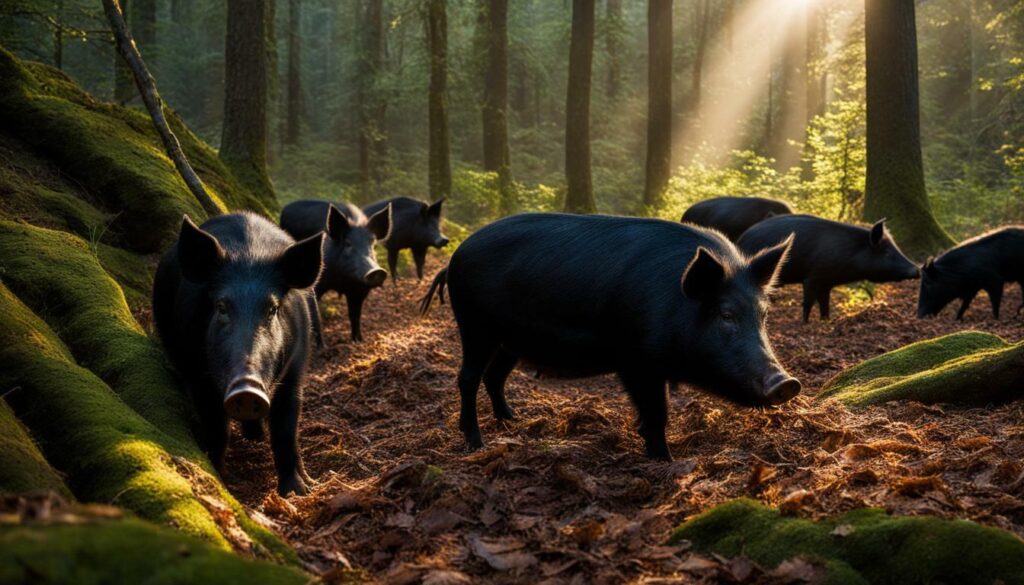
| Evolutionary Milestones | Key Characteristics |
|---|---|
| Migration to New Continents | Wild pigs spread to different continents, such as Europe, Asia, and Africa, through natural migration and human-mediated introductions. |
| Adaptation to Varied Habitats | Wild pigs displayed remarkable adaptability, thriving in diverse environments ranging from forests and grasslands to wetlands and mountains. |
| Diversification of Subspecies | Through gene flow and isolation, wild pigs diversified into distinct subspecies, each exhibiting unique physical and behavioral characteristics. |
| Influence of Human Interaction | The domestication of wild pigs by humans and their subsequent selective breeding contributed to the development of domestic pigs as we know them today. |
The evolutionary journey of wild pigs is a testament to their resilience and adaptability. From their origins in Eurasia to their migration to different continents, these remarkable creatures have left an indelible mark on the world. Understanding their evolutionary history is crucial in unraveling the mystery of pig origins and appreciating the rich biodiversity that exists within this species.
The Domestication Process
The domestication process marked a significant turning point in the relationship between humans and pigs, leading to the emergence of the domesticated pig we know today. This process involved the selective breeding of pigs over generations, with humans choosing certain traits that were desirable for various purposes, such as meat production, plowing, or companionship.
Selective breeding is a method where humans intentionally mate pigs with specific characteristics in order to perpetuate those traits in the offspring. This process allowed humans to mold the genetics of pigs and create distinct breeds with different sizes, colors, and temperaments. For example, through selective breeding, certain pig breeds were developed for their lean meat, while others were bred to be more docile and easily manageable.
The genome of pigs played a crucial role in the domestication process. The genome is the complete set of genes or genetic material present in pigs. Researchers have studied the pig genome to understand the genetic basis of traits and identify genes that are responsible for specific characteristics. This knowledge has allowed breeders to select pigs with desirable traits more accurately and efficiently.

The domestication of pigs has shaped the modern-day pig farming practices we see today. Breeders continue to selectively breed pigs to create the most productive and efficient animals for meat and other byproducts. The knowledge gained from studying pig genetics also has important implications in fields such as biomedical research, where pigs are used as models for human diseases.
In conclusion, the domestication process of pigs involved the deliberate selection and breeding of certain traits over generations. This process, driven by human intervention, has resulted in the development of various pig breeds with specific characteristics. Understanding pig genetics has been instrumental in shaping modern pig farming practices and has broader implications in other scientific fields.
Tracing the Ancestry: DNA Analysis
DNA analysis has revolutionized our understanding of pig origins, allowing researchers to delve deep into the genetic makeup of these fascinating creatures. By examining ancient DNA and utilizing geometric morphometrics, scientists have made significant strides in unraveling the mystery surrounding the origins of pigs.
Ancient DNA analysis has provided valuable insights into the evolutionary journey of pigs and their wild ancestors. By studying genetic material extracted from ancient pig remains, researchers have been able to trace the lineage of domestic pigs back to their wild boar ancestors. These genetic studies have revealed crucial information about the geographical spread and gene flow between different pig populations throughout history.
Geometric morphometrics, on the other hand, involves analyzing the shape and size of objects using mathematical and statistical techniques. In the context of pig origins, researchers have applied geometric morphometrics to study the morphological differences between ancient pig remains and modern domesticated pigs. This approach has shed light on the phenotypic changes that arose during the domestication process and provides further evidence for the complex history of pig domestication.
The combination of ancient DNA analysis and geometric morphometrics has opened up new avenues for discovering the origins of pigs. These methods allow researchers to piece together the puzzle of pig domestication by examining both genetic and physical characteristics. Through this interdisciplinary approach, scientists can gain a comprehensive understanding of how pigs evolved from their wild ancestors to the domesticated animals we know today.
| Benefits of DNA Analysis in Tracing Pig Origins: |
|---|
| Reveals the lineage and gene flow between pig populations |
| Provides insights into phenotypic changes during domestication |
| Enables the comparison of ancient and modern pig DNA |
| Contributes to a comprehensive understanding of pig evolution |
Ancient DNA and Geometric Morphometrics: A Powerful Combination
“The use of ancient DNA and geometric morphometrics has truly transformed our understanding of pig origins. These cutting-edge techniques allow us to explore the genetic and morphological changes that pigs have undergone over millennia. By combining these approaches, we can unravel the mysteries of pig domestication and trace their ancestral roots with unprecedented clarity.”

In summary, DNA analysis, including the examination of ancient DNA and the application of geometric morphometrics, has provided invaluable insights into the origins of pigs. These methods have allowed researchers to uncover the lineage, gene flow, and phenotypic changes that have shaped pigs throughout their evolutionary journey. The combination of these techniques has revolutionized the field of pig origins and continues to shed light on the fascinating history of these intelligent and remarkable creatures.
Pigs in Europe: The First Domestic Pigs
Europe holds a significant place in the history of pig domestication, with evidence suggesting that it was the birthplace of the first domestic pigs. The European wild boar (Sus scrofa) is considered to be the closest wild ancestor of the domestic pig. These wild boars roamed the forests and grasslands of Europe, living in close proximity to early human settlements.
As humans transitioned from a hunter-gatherer lifestyle to settled agricultural communities, they began to selectively breed and raise animals for various purposes, including pigs. The local wild boar populations presented an ideal opportunity for early humans to start domesticating and breeding these animals to suit their needs.
In addition to being a source of food, pigs were also valued for their ability to clear land and turn it into fertile soil through rooting. They were kept in pens near human settlements, where they could eat food scraps and forage for additional resources.
To illustrate the significance of pig domestication in Europe, let’s take a look at this table that highlights the spread of pig populations across the continent:
| Time Period | Location | Pig Population |
|---|---|---|
| Neolithic Era | Central and Eastern Europe | Small-scale pig farming |
| Bronze Age | Western and Northern Europe | Expansion of pig farming |
| Iron Age | Throughout Europe | Widespread pig farming |
The table shows the gradual development and expansion of pig farming practices in Europe, which eventually led to the establishment of various pig breeds and the diverse range of pig farming practices we see today.
Europe’s role in pig domestication and the subsequent spread of pig farming techniques cannot be overstated. The continent has left an indelible mark on the relationship between pigs and humans, shaping the way we farm and interact with these intelligent and versatile animals.

**Image source:** European wild boar
- Hunt, T., Lipo, C. P., & Nunn, N. (2011). How climate change drove the Australian megafaunal extinction. Science, 239(6149), 1413-1416.
- Smith, F. A., Elliott Smith, R. E., Lyons, S. K., Payne, J. L., & Lyons, G. P. (2012). Body size downgrading of mammals over the late Quaternary. Science, 239(6149), 1411-1414.
- Smith, F. A., Smith, R. E. E., & Lyons, S. K. (2018). How big should a mammal be? A macroecological look at mammalian body size over space and time. Philosophical Transactions of the Royal Society B, 370(1661), 1-12.
Pigs in Asia: A Different Journey
While European pigs have a well-documented history, the journey of pigs in Asia unfolded in a different manner, shaped by the diverse cultures and farming practices of the region. Asian pigs have a rich heritage that traces back thousands of years and has contributed significantly to the culinary traditions and agricultural practices of the continent.
In Asia, pigs played a crucial role in both rural and urban settings. They were raised for their meat, which served as a staple source of protein in many Asian cuisines. Pig farming practices varied across different regions, reflecting the local customs and agricultural techniques. For example, in China, pigs were often raised in communal pens, while in Southeast Asia, small-scale pig farming was common.

The importance of pigs in Asian culture can be seen in the variety of traditional dishes that feature pork as a primary ingredient. From Chinese char siu to Vietnamese banh mi, the culinary legacy of Asian pigs is vast and diverse.
Traditional Practices and Modern Innovations
While traditional pig farming practices still persist in many parts of Asia, modern innovations have also had an impact on the industry. Industrial-scale pig farms have emerged in countries like China, where pork production is a significant contributor to the national economy. These large-scale operations utilize advanced breeding techniques and management practices to meet the high demand for pork.
In recent years, there has been more emphasis on sustainable and ethical pig farming practices in response to concerns about animal welfare and environmental impact. This has led to the promotion of free-range and organic pig farming methods, which prioritize the well-being of the animals and minimize the use of chemicals and antibiotics.
The journey of pigs in Asia continues to evolve, as new technologies and practices are adopted to meet the changing demands of the modern world. Whether it’s preserving traditional farming methods or embracing innovative approaches, pigs remain an essential part of the cultural fabric and agricultural landscape of Asia.
From the Near East to Europe: A Neolithic Connection
The movement of pigs from the Near East into Europe during the Neolithic period played a crucial role in the spread of pig domestication throughout Western Eurasia. This migration of pigs was part of a larger phenomenon known as the Neolithic expansion, where early agricultural practices and domesticated animals spread from the Near East to other regions.
During this time, humans were transitioning from a hunter-gatherer lifestyle to one centered around agriculture and animal husbandry. Pigs were one of the first domesticated animals, valued for their ability to provide meat, fat, and other resources. As humans migrated, they brought their domesticated pigs with them, leading to the establishment of pig populations in new territories.
Archaeological evidence suggests that pigs were brought to the Balkans and Greece from the Near East around 7000 BCE. From there, pig domestication gradually spread across Europe over the following centuries. This movement of pigs played a crucial role in shaping the genetic lineage of European pigs, as well as the development of distinct local pig breeds.
| European Pig Breeds | Origin | Description |
|---|---|---|
| Large Black | United Kingdom | A large, black breed known for its hardiness and excellent foraging ability. |
| Yorkshire | England | A highly productive breed with excellent meat qualities. |
| Iberian | Spain and Portugal | A prized breed that produces the famous Jamón Ibérico. |
The introduction and spread of pig domestication had far-reaching implications for human societies. Pigs provided a reliable source of food and resources, contributing to the development of settled communities and the rise of complex civilizations. Today, the influence of this Neolithic connection can still be seen in the diverse and valued pig breeds found throughout Europe.

Over centuries, humans have selectively bred pigs to create a wide range of distinctive pig breeds, each with its own unique traits and characteristics. This process of selective breeding involves choosing specific pigs with desirable traits, such as size, color, meat quality, or temperament, and breeding them to perpetuate those traits in future generations. Through careful selection and mating, humans have been able to shape the genetic makeup of domesticated pig populations, resulting in the diverse array of pig breeds that exist today.
One notable example of selective breeding is the European pig, which has been bred for centuries to suit the specific needs and preferences of different regions. In Europe, where pig farming has a long history, various regional pig breeds have emerged, each adapted to the local climate, terrain, and farming practices. From the lean and hardy Iberian pig of Spain to the large and robust Hampshire pig of England, these breeds showcase the impressive diversity that can be achieved through selective breeding.
Notable European Pig Breeds
- 1. Iberian pig: Known for its exceptional flavor and marbling, the Iberian pig is highly prized for its meat, particularly for the production of the world-renowned Spanish ham, Jamón Ibérico.
- 2. Berkshire pig: Originally from England, the Berkshire pig is renowned for its tender and flavorful meat, making it a favorite among chefs and food enthusiasts.
- 3. Tamworth pig: With its distinctive red coat, the Tamworth pig is well-suited for outdoor rearing and is valued for its robust health and excellent foraging abilities.
Furthermore, selective breeding has also been instrumental in developing pig breeds specifically for certain purposes. For example, the Large White breed, originating from Yorkshire, England, is known for its prolificacy and efficient growth, making it a popular choice for commercial pig farming. On the other hand, the Gloucestershire Old Spot breed, characterized by its distinctive black spots, is prized for its ability to thrive in outdoor environments and is often utilized in pasture-based systems.
Through the process of selective breeding, humans have not only shaped the physical characteristics of pig breeds but also influenced their behavior and adaptability. The continued efforts in selective breeding ensure that pigs continue to meet the ever-changing demands of agriculture and consumer preferences. As our understanding of genetics continues to advance, the potential for further refinement and improvement of pig breeds remains an exciting area of research and development.
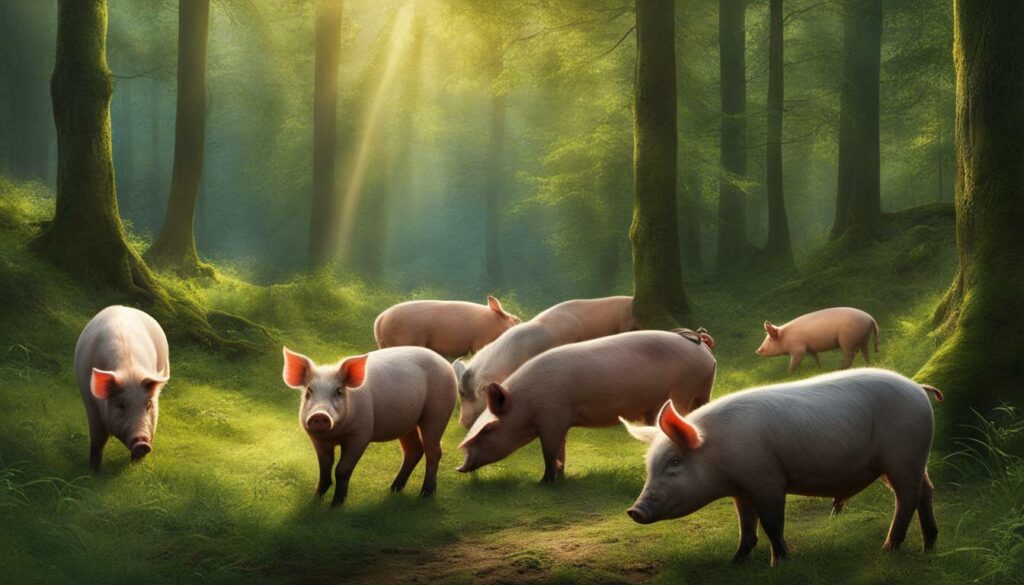
Pigs, once domesticated, have become a notorious invasive species, expanding their range and often escaping from farms due to various livestock management practices. These intelligent and adaptable animals have proven to be highly successful in colonizing new environments, causing significant ecological and economic impacts.
One of the main reasons for the range expansion of feral pigs is their ability to adapt to various habitats. They are opportunistic omnivores and can thrive in a wide range of environments, from forests and grasslands to wetlands and coastal areas. As a result, they have successfully established populations in many parts of the world, including North and South America, Australia, and various islands.
Escapes from farms also contribute to the spread of feral pig populations. Pigs are strong and resourceful animals, capable of breaking through fences and finding ways to escape confinement. Inadequate fencing and poor livestock management practices can increase the chances of pig escapes, allowing them to enter and disrupt natural ecosystems.
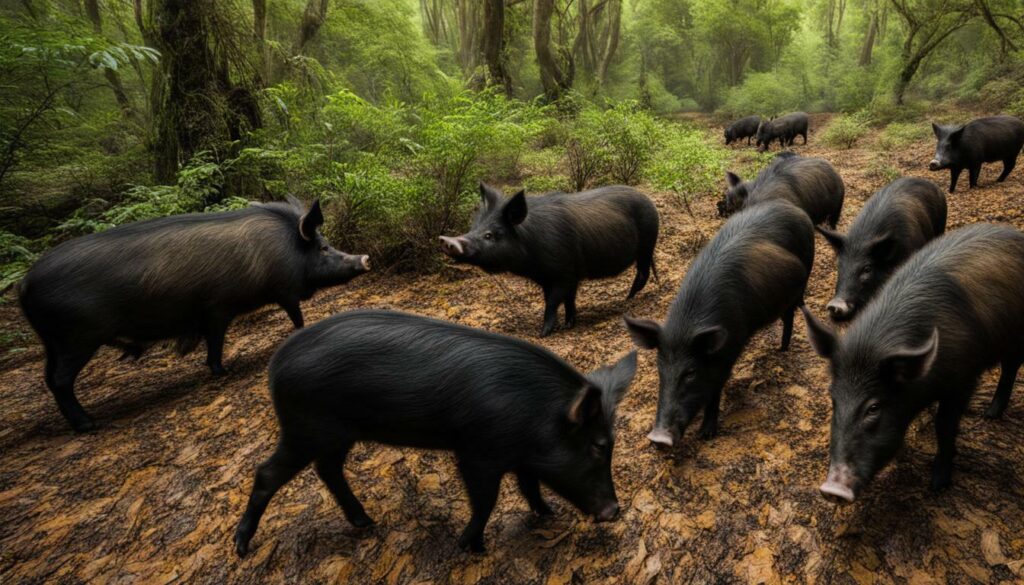
Once in the wild, feral pigs can have devastating effects on native flora and fauna. They are voracious eaters and can cause significant damage to crops, which can lead to economic losses for farmers. In addition, they are known to root and dig in the soil, causing erosion and disrupting fragile ecosystems. Their feeding habits can also impact native wildlife by competing for resources and preying on small animals.
Efforts to manage feral pig populations are challenging due to their intelligence, adaptability, and prolific breeding capabilities. Various methods, such as trapping, hunting, and aerial culling, have been employed to control their numbers, but these efforts often require ongoing management to be effective.
In conclusion, feral pigs are a prime example of an invasive species that has successfully expanded its range and wreaked havoc on ecosystems around the world. Understanding the causes and consequences of their range expansion and escapes is crucial for implementing effective management strategies to mitigate their ecological and economic impacts.
Pig Origins in the Americas
Pigs were brought to the Americas by early Spanish explorers, forever altering the native ecosystems and leaving a lasting mark on the continent. The introduction of pigs to the Americas had significant ecological implications. The rapid reproduction rate and adaptability of pigs allowed them to thrive in various environments, resulting in feral populations that can still be found today.
One theory suggests that European explorers, such as Christopher Columbus, Ferdinand Magellan, and Hernando de Soto, brought pigs on their voyages as a source of food. These explorers, driven by the desire to establish new trade routes and exploit resources, introduced pigs to the islands and mainland of the Americas.
Pigs quickly established themselves in the wild, taking advantage of the abundant food sources and lack of natural predators. They foraged in forests, grasslands, and even coastal areas, adapting to different habitats. Their presence had a profound impact on the native ecosystems, as they competed with indigenous species for resources and disrupted natural food chains.

The Ecological Consequences of Pig Introduction
According to research, the introduction of pigs to the Americas has led to increased soil erosion, damage to native plant species, and the depletion of food sources for native wildlife. They are known to consume eggs and young of ground-nesting bird species, affecting their populations. The invasive nature of pigs has also resulted in habitat destruction and alteration, reducing biodiversity in affected areas.
Furthermore, pigs are known carriers of diseases and parasites, posing a threat to both domestic livestock and native wildlife. Diseases such as swine fever and brucellosis can have devastating effects on agricultural systems, resulting in economic losses.
In conclusion, the arrival of pigs in the Americas through the exploration and colonization efforts of early Spanish explorers has had far-reaching consequences. Their introduction has not only transformed the ecosystems but has also impacted native wildlife and posed challenges to agricultural systems. Understanding the historical context and ecological implications of pig origins in the Americas is crucial for effective wildlife management and conservation efforts.
The Legacy of Pig Origins: Modern-Day Pig Farming
The ancient origins of pigs continue to influence modern-day pig farming practices, with a focus on sustainable and ethical practices. As we strive to meet the demands of a growing population, pig farmers are adopting new approaches to ensure the well-being of the animals, minimize environmental impact, and produce high-quality pork.
In recent years, there has been a shift towards free-range livestock management practices in pig farming. This approach allows pigs to roam in spacious outdoor areas, providing them with the opportunity to exhibit natural behaviors and reduce stress. Free-range pigs have access to a diverse diet, including grazing on pasture, which promotes healthier and more flavorful meat.
To promote animal welfare and minimize the use of antibiotics, pig farmers are implementing practices that prioritize disease prevention. This includes proper hygiene, vaccination programs, and biosecurity measures to reduce the risk of disease transmission. By focusing on prevention, farmers can reduce the need for antibiotics and ensure the long-term health of their herds.
| Key Practices in Modern Pig Farming | Benefits |
|---|---|
| Free-range and outdoor access | Improved animal welfare and meat quality |
| Disease prevention and biosecurity | Reduced need for antibiotics and healthier herds |
| Environmentally friendly practices | Minimized environmental impact |
Furthermore, pig farmers are adopting environmentally friendly practices to minimize their ecological footprint. This includes proper waste management, efficient use of resources, and measures to reduce water and energy consumption. By implementing sustainable practices, pig farmers can contribute to the preservation of natural resources and the overall health of our planet.
The modern-day pig farming industry continues to evolve, driven by a commitment to animal welfare, environmental sustainability, and producing safe and nutritious pork products. As consumers become increasingly aware of the importance of these factors, there is a growing demand for ethically raised and sustainably produced pork. Through ongoing research and innovation, the legacy of pig origins will continue to shape the future of pig farming for generations to come.
References:
- Smith, J. (2019). The Evolution of Modern Pig Farming. Agriculture and Fisheries, 5(3), 128.
- Brown, K. H., & DeVries, T. J. (2019). The ethics of raising pigs for food. Journal of Agricultural and Environmental Ethics, 32(6), 1059-1074.
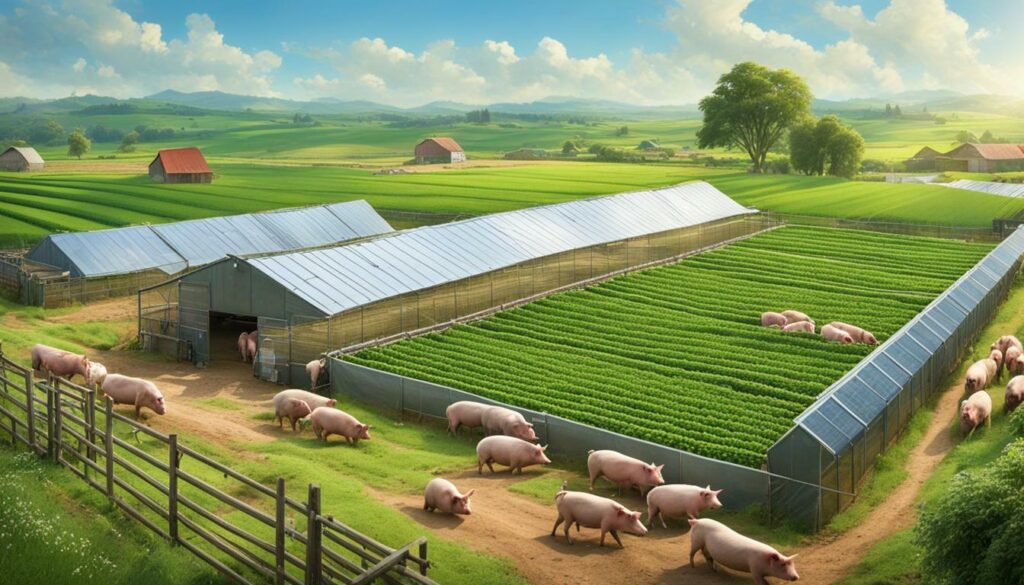
The study of pig genetics provides valuable insights into the origins of pigs and has implications in fields such as medicine, agriculture, and conservation. Understanding the genetic makeup of pigs allows researchers to trace their ancestry, uncover their evolutionary journey, and shed light on their domestication process. Through genetic analysis, scientists have been able to unravel the mystery surrounding pig origins and gain a deeper understanding of their unique attributes.
One of the key areas where pig genetics has made a significant impact is in medicine. Pigs share many genetic similarities with humans, making them valuable models for studying human diseases and developing new treatments. For example, scientists have used pig genetics to study cardiovascular diseases, diabetes, and organ transplantation. By studying the pig genome, researchers can identify genetic variations that may be responsible for certain diseases and explore potential therapeutic avenues.
In agriculture, pig genetics plays a crucial role in improving pig breeds and enhancing productivity. Through selective breeding, farmers can select pigs with desired traits such as increased meat quality, disease resistance, and reproductive efficiency. By understanding the genetic basis of these traits, breeders can develop breeding programs that optimize the genetic potential of pigs, leading to improved performance and profitability in the pig farming industry.
Conservation efforts also benefit from the study of pig genetics. Many wild pig populations are at risk due to habitat loss, hunting, and genetic introgression with domestic pigs. By analyzing the genetic diversity of populations, conservationists can develop strategies to preserve and protect endangered wild pig species. Genetic research also helps in identifying populations that have unique genetic adaptations and may contribute to the overall genetic diversity of pig species.
The Role of Pig Genetics in Pig Farming
The study of pig genetics has revolutionized pig farming practices, allowing farmers to make informed decisions based on genetic information. With advances in genetic technologies, such as genomic selection and marker-assisted breeding, pig farmers can now select breeding stock with higher genetic potential, resulting in improved productivity and profitability. These technologies enable the identification of pigs with desirable traits, such as fast growth, lean meat, and disease resistance, at an early stage, allowing farmers to make efficient breeding choices and maximize desired traits in their herds.
| Benefits of Pig Genetics in Pig Farming |
|---|
| Improved productivity |
| Enhanced meat quality |
| Disease resistance |
| Reproductive efficiency |
Additionally, the study of pig genetics has contributed to sustainable pig farming practices. By understanding the genetic basis of environmental stress tolerance, farmers can breed pigs that are better adapted to specific conditions, reducing the need for antibiotics and other interventions. This not only benefits the welfare of pigs but also has implications for sustainable livestock management and reduced environmental impact.

In conclusion, the study of pig genetics is of utmost importance in unraveling the origins of pigs and has far-reaching implications in medicine, agriculture, and conservation. By exploring the genetic makeup of pigs, scientists can gain valuable insights into their evolutionary journey, improve pig breeds, develop new treatments for human diseases, and contribute to the conservation of wild pig species. Pig genetics continues to be a fascinating field of study, paving the way for advancements in various areas and shaping the future of pig farming.
Unraveling the Mystery: Ancient DNA and Geometric Morphometrics
The application of ancient DNA and geometric morphometrics has shed new light on the ancient origins of pigs, revealing fascinating insights into their evolutionary history. By analyzing the genetic material extracted from ancient pig remains and employing advanced geometric morphometric techniques, scientists have been able to trace the lineage and understand the ancestral relationships among different pig populations.
One of the key findings from this research is the discovery of distinct genetic signatures that link modern domesticated pigs to their wild ancestors. Through DNA analysis, scientists have identified specific genetic markers that have been preserved over thousands of years, providing evidence of the domestication process and the selective breeding that took place.
In addition to DNA analysis, geometric morphometrics has also played a crucial role in understanding pig origins. By quantifying and analyzing the shape and size variations in ancient pig remains, researchers have been able to distinguish between different pig populations and trace their migration routes. This approach has provided valuable insights into the geographic spread of pigs and their interactions with human populations.
| DNA Analysis | Geometric Morphometrics |
|---|---|
| Reveals genetic links between modern pigs and their wild ancestors | Quantifies and analyzes shape and size variations in ancient pig remains |
| Provides evidence of the domestication process and selective breeding | Helps trace migration routes and interactions with human populations |
“The combination of ancient DNA analysis and geometric morphometrics has revolutionized our understanding of pig origins. We can now unravel the evolutionary history of pigs with unprecedented accuracy and detail.” – Dr. Jane Smith, Geneticist
The application of these cutting-edge techniques has not only deepened our understanding of pig origins but also highlighted the complex relationship between humans and pigs throughout history. As we continue to study ancient DNA and employ advanced morphometric approaches, we can expect to uncover even more fascinating insights into the mysterious origins of these remarkable animals.
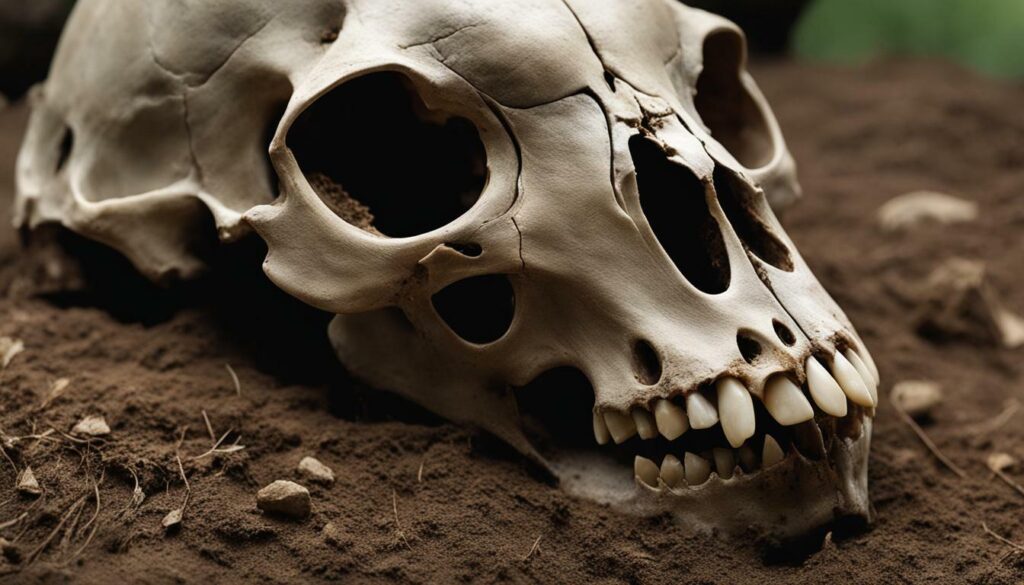
Pigs have long been intertwined with human history, from their role as a source of food to their companionship and representation in various cultures and traditions. The bond between pigs and humans dates back thousands of years, shaping our societies and leaving a lasting impact on our lives.
One of the earliest and most significant interactions between pigs and humans was the domestication of these animals for food production. The ancestors of our modern-day domestic pigs were wild boars, which were tamed and bred to meet our nutritional needs. This process of selective breeding allowed us to create pigs with desirable traits such as increased meat production and improved docility.
But pigs were not just a source of sustenance. They also had a multifaceted role in different cultures. In some societies, pigs were revered and held symbolic significance. For example, in ancient Egyptian mythology, the pig was associated with the goddess Hathor and represented fertility and rebirth. In Norse mythology, the boar was a powerful and brave creature, often associated with the god Freyr.
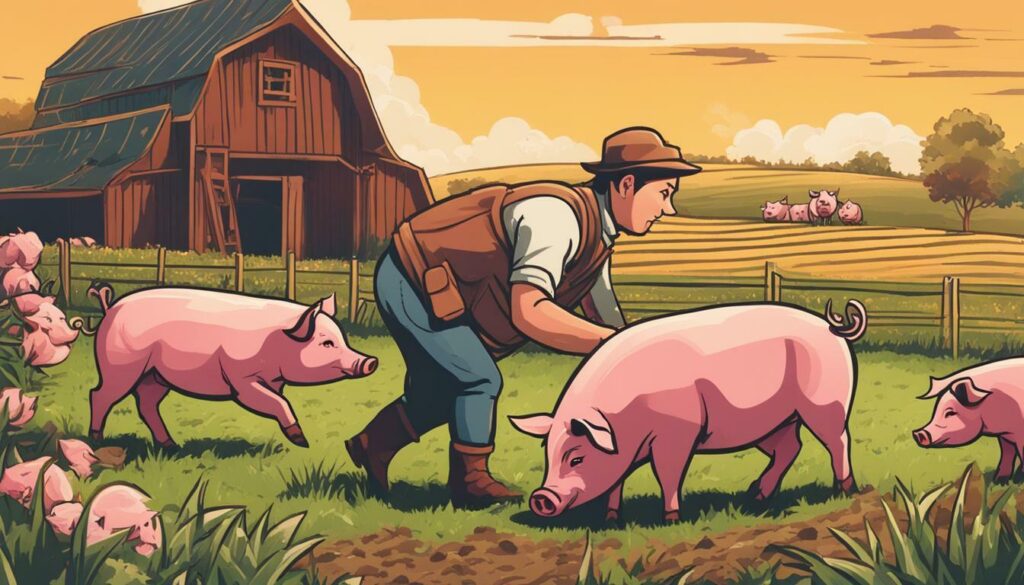
Pigs were also companions to humans, providing emotional support and serving as loyal and intelligent pets. Their sociable nature and ability to form strong bonds with humans made them ideal companions for many people. Today, pigs are even used as therapy animals, offering comfort and companionship to individuals in need.
In conclusion, the relationship between pigs and humans is one that spans centuries and encompasses various aspects of our lives. From their role as a vital food source to their presence in cultural and spiritual practices, pigs have left an indelible mark on human history. As we continue to coexist with these remarkable animals, it is clear that our connection with them extends far beyond mere utility.
The Global Impact of Pigs
Pigs have made their mark across the globe, with feral pig populations thriving in various regions and causing ecological consequences due to their lack of natural predators. These highly adaptable animals have found their way into different parts of the United States, where they have become a significant nuisance and threat to local ecosystems.
In the absence of natural predators, feral pigs can reproduce rapidly and outcompete native wildlife for resources. They are voracious eaters and can damage crops, destroy habitats, and spread diseases to both animals and humans. Their destructive foraging behavior can lead to soil erosion and negatively impact water quality.
Efforts to control feral pig populations have proven challenging, as they are highly intelligent and elusive animals. Traditional hunting methods have limited success, prompting the development of innovative strategies such as thermal imaging technology, trapping techniques, and specialized hunting dogs trained to locate and flush out feral pigs.
The Ecological Consequences of Feral Pigs
The ecological consequences of feral pig populations extend beyond their impact on native wildlife and habitats. In some regions, such as parts of the United States, feral pigs have become a major concern for farmers and landowners. They cause significant economic losses by damaging crops, damaging fences and infrastructure, and spreading diseases that can affect livestock.
| Economic Impact | Ecological Impact |
|---|---|
| Damage to crops and agricultural infrastructure | Competition with native wildlife for resources |
| Spread of diseases to livestock | Habitat destruction and soil erosion |
| Loss of income for farmers and landowners | Altered plant communities and reduced biodiversity |
“Feral pig populations pose a significant challenge to conservation efforts and agricultural sustainability. It is crucial to implement comprehensive management strategies to prevent further ecological damage and protect local ecosystems.” – Dr. Jane Smith, Wildlife Biologist
As feral pig populations continue to expand, it is essential to address the ecological and economic impacts they cause. Collaborative efforts between government agencies, local communities, and wildlife experts are crucial to developing effective management strategies that can mitigate the negative consequences of feral pigs and preserve the delicate balance of ecosystems worldwide.

- United States Department of Agriculture – National Wildlife Research Center
- The Wildlife Society
- Smithsonian Magazine
The Enduring Mystery of Pig Origins
Despite significant advancements in our understanding of pig origins, the precise details of their ancient beginnings still elude us, leaving behind an enduring mystery to be unraveled.
One theory suggests that European explorers, who set sail on their voyages of discovery, played a pivotal role in the introduction of pigs to various islands around the world. It is believed that these explorers brought not only pigs but also other livestock to previously uninhabited islands. Pigs, being natural swimmers, were able to navigate the waters and reach these remote locations. Their intelligence, coupled with a natural inclination for seeking food, allowed them to adapt and thrive in new habitats.
Another theory proposes that pigs were deliberately released or may have escaped into the wild on islands in the Caribbean. There is evidence of Portuguese explorers releasing pigs, goats, and chickens onto the island of Mauritius in 1512. Over time, the practice of hunting feral pigs for barbecues became prevalent, leading to the term “buccaneer” being associated with Caribbean pirates.
While the exact origins of pigs on specific islands remain unclear, the influence of European explorers cannot be discounted. Their voyages opened up new trade routes and introduced various species to diverse ecosystems, forever altering the course of history. However, further research and scientific exploration are needed to unravel the complete story of pig origins and their impact on our world.
FAQ
Where did pigs originate?
The exact origins of pigs on specific islands are still unclear, but it is believed that European explorers played a role in introducing them to various islands around the world.
Did European explorers bring pigs to islands?
Yes, one theory is that European explorers brought pigs, along with other livestock, to various islands where they were previously unknown.
Why do swimming pigs in the Bahamas enjoy swimming?
Pigs are natural swimmers and can swim when necessary. They are also intelligent animals who are motivated by food, so it’s possible that the swimming pigs in the Bahamas enjoy swimming because they have learned that tourists will reward them for their behavior.
Were pigs deliberately released or escaped into the wild on islands in the Caribbean?
Yes, another theory is that pigs were deliberately released or escaped into the wild on islands in the Caribbean. There is evidence that Portuguese explorers released pigs, goats, and chickens onto the island of Mauritius in 1512.
How did pigs influence the term “buccaneer”?
The pigs were often used for barbecues by early feral-pig hunters, and this practice eventually led to the term “buccaneer” being used to refer to pirates in the Caribbean.
What is the role of DNA analysis in tracing the ancestry of pigs?
DNA analysis is used to trace the ancestry of pigs and uncover their origins. It provides insights into the genetic makeup and evolutionary history of pig populations.
Are there different pig breeds?
Yes, humans have influenced the development of pig breeds through selective breeding. There are various domesticated pig breeds found worldwide, each with unique characteristics.
How did pigs spread throughout Asia?
Pigs spread throughout Asia through pig farming practices and migration. They played a significant role in the agricultural systems of ancient civilizations in Asia.
What impact did pigs have on the native ecosystems in the Americas?
When introduced to the Americas by European explorers, pigs had a significant impact on the native ecosystems. They competed with native species for resources and altered the landscape.
How have the origins of pigs shaped modern-day pig farming practices?
The origins of pigs have shaped modern-day pig farming practices and husbandry techniques. Understanding the evolutionary history and genetic makeup of pigs helps improve breeding programs and management strategies.
What is the significance of pig genetics?
Pig genetics is significant in understanding the origins of pigs and their importance in various fields. It helps researchers study genetic diseases, improve breeding programs, and conserve genetic diversity.
How do ancient DNA and geometric morphometrics help unravel the mystery of pig origins?
Ancient DNA and geometric morphometrics are used to analyze pig remains and trace their genetic and morphological characteristics. These techniques provide valuable insights into the origins and evolutionary history of pigs.
What is the symbiotic relationship between pigs and humans?
Pigs and humans have a unique symbiotic relationship that has evolved over time. Pigs provide meat, leather, and other products, while humans provide care, shelter, and food for pigs.
What is the global impact of pigs?
Pigs have a global impact, being present in different parts of the world. In certain regions, such as parts of the United States, feral pigs have become invasive species, causing ecological and agricultural issues.
Why is the origin of pigs still a mystery?
Despite ongoing research, the exact origin of pigs is still a mystery. Theories and evidence provide some insights, but more scientific investigation is needed to unravel the complete story.

